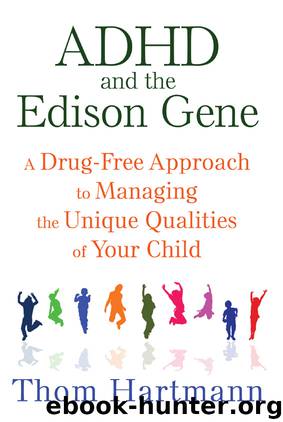ADHD and the Edison Gene by Thom Hartmann

Author:Thom Hartmann
Language: eng
Format: epub
Tags: Psychology/Health
Publisher: Inner Traditions/Bear & Company
Published: 2015-09-04T16:00:00+00:00
EEG Neurofeedback
One of the most promising new therapeutic interventions for children who have difficulty paying attention in school or other environments is called EEG neurofeedback. In several recent studies, it has been shown to be far more effective than even Ritalin in improving study skills and attention during classroom time.
EEG neurofeedback works by placing external electrodes on a child’s head to monitor the brain’s electrical activity, and then allowing the child to play a video game, using his own brain waves to drive the game. The principle of the system is that there are specific types of brain waves that are produced when a person is using focused attention, and different types of brain waves that are produced when a person is distractible or daydreaming. Whenever the child is producing focused, concentrated brain waves, the video game on the screen shows him winning (there are a variety of screen displays, from car races to fighter planes to simple lines that go up or down). Often there is also auditory feedback, with friendly sounds that indicate when the child is winning and buzzers or negative sounds that indicate when they’ve drifted off.
The mechanism by which EEG neurofeedback works is nothing new: It’s called learning. The more the child “wins” the game, the more he experiences being in a focused state. He also notices, from the feedback on the screen and through the speakers, what it feels like inside his mind and body when his attention wanders, and learns to catch himself at such moments and return to a focused state.
Modern cultures have a long tradition of using biofeedback devices to train young people to attend and concentrate. In Christian traditions, rosaries and prayer beads have been used for millennia—when the faithful’s attention drifts away from the prayer, the “biological feedback” of feeling the next bead acts as a reminder to return attention to the task or prayer at hand. Similar devices are found in Buddhist, Muslim, and Hindu cultures.
Another form of biofeedback is the family meal. In traditional European and early American cultures, mealtimes—particularly dinners—required the entire family to get together, and children had to learn to monitor external social cues to control and calibrate their behavior. Because family approval is so much more essential to a child than is the approval of a teacher (or even a peer group, at least at early ages), children learned to notice their attention.
Since the era of television and the trend, begun in the 1980s, of exporting well-paying industrial jobs to developing countries, which has led to the necessity of two incomes per household, the family meal has all but vanished in most homes. Whereas in 1960 in most of the industrialized world, a single wage-earner could raise a family with the paycheck from a forty-hour-a-week job, today more than half of all families must have two incomes to maintain the same standard of living. Additionally, half of all children in America now live in a single-parent home, and that parent is usually at work during the day.
Download
This site does not store any files on its server. We only index and link to content provided by other sites. Please contact the content providers to delete copyright contents if any and email us, we'll remove relevant links or contents immediately.
| Disabilities | Hyperactivity |
The Out-of-Sync Child by Carol Stock Kranowitz(2022)
The Gender Creative Child by Diane Ehrensaft & Norman Spack(1735)
Aspergirls by Rudy Simone(1655)
Your Soul's Plan by Robert Schwartz(1643)
Be Different by John Elder Robison(1602)
My Child's Different by Elaine Halligan(1461)
101 Tips for the Parents of Boys with Autism by Ken Siri(1431)
Meditation: Meditation For Beginners - How to Meditate For Lifelong Peace, Focus and Happiness (Mindfulness, Meditation Techniques) by Price Sara Elliott(1396)
The Sensory Child Gets Organized by Carolyn Dalgliesh(1392)
Asperger Syndrome (Autism Spectrum Disorder) and Long-Term Relationships by Ashley Stanford(1375)
ADHD by Mark Selikowitz(1353)
Nerdy, Shy, and Socially Inappropriate by Cynthia Kim(1309)
An Adult with an Autism Diagnosis by Gillan Drew(1305)
Animal-assisted Interventions for Individuals with Autism by Temple Grandin(1283)
Seeing Ezra by Kerry Cohen(1263)
The Yoga Bible by Christina Brown(1263)
Somebody Else's Kids by Torey Hayden(1238)
Baby Signing for Dummies by Jennifer Watson(1230)
Overcoming ADHD by Stanley I. Greenspan & Jacob (con) Greenspan(1202)
